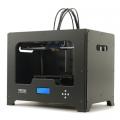Results 11 to 20 of 52
-
01-07-2016, 10:45 AM #11
I would add a few things to this list:
This is absolutely untrue. PLA has been around since the 1930's (if I recall correctly it was developed by DuPont in 1932) and is used extensively in injection moulding particularly in the food packaging industry (yoghurt tubs, etc) and also disposable cutlery and plates (like camping gear).
-
01-07-2016, 02:36 PM #12
I Print almost exclusively with ABS, and while it's slightly more tricky to work with than simple plain Jane PLA, it's not nearly as difficult as some of the specialty PLA's (from what I've been reading). From my experience with ABS, I would almost go as far as saying all your ABS cons are grasping at straws, with maybe #1 being the exception. While it's not impossible to keep small ABS objects from warping without an enclosure, it does make it easier.
All that said, I do suspect there are many PLA filaments out now with much better characteristics than ABS, but man some of those filaments are crazy expensive, and ABS is cheap for strength.
-
01-08-2016, 08:21 AM #13
4) can be tricky to make stick to print surfaces. Absolutely not true
Not sure what fairy dust you use to make this not true. It's unfortunately very true for most folks that try ABS 3D printing.
-
01-08-2016, 08:36 AM #14
Must be the same 'fairy dust' I'm using, because it's a non-issue for me as well. No problems with ABS here..
-
01-09-2016, 02:35 PM #15
!!! Wow, where can I get some Aqua-net Spray with 'fairy dust' in it ???

My large ABS prints all look like rockers for rocking-chairs !
-
01-09-2016, 03:10 PM #16
-
01-09-2016, 05:23 PM #17
That's what you guys keep saying but I've not heard any Good suggestions about how to fix the 'Extreme Warping',
except for 'Fairy Dust' !
I've tried All the suggested nozzle and bed temps and speed changes, and it does Not help !
I'm certainly not going to use some radical Glue to hold it down !
If Aqua-net can not hold it down, then it will not be used in our printer !
Last edited by EagleSeven; 01-09-2016 at 05:30 PM.
-
01-10-2016, 01:06 AM #18
You haven't heard any good suggestions? I have been repeating this since I joined: enclose your print chamber and preheat it before printing.
-
01-10-2016, 05:54 AM #19don't know where you're doing your reading - but I've tried most of the weird and wonderful filaments out there and they ALL stick to gluestick, none of them warp and they all print just as easily as decent pla.it's not nearly as difficult as some of the specialty PLA's (from what I've been reading).
Most of them don't need heated buildplate - none of them need a heated enclosure. And because you don't need rafts and prints rarely fail - even the expensive ones are actually pretty cost effective. As long as you design and print properly :-)
I did do a fair bit of printing with abs, before, I finally tried pla and realised everything I'd heard, was just so much nonsense.
Don't have heated enclosure, always used a raft. Apart from the odd crack and ocasional issues getting the raft off after a long print - it printed okay.
But just okay - you needed to adjust for shrinkage, and that was annoying - don't need to do that with pla.
Hell I even printed a secret heart box with abs.
But the smell when it's printing is unpleasant, acetone is not good for you and my pla prints - so far - have been stronger, less brittle, stiffer and just all round better parts.
I don't print figurines or pretty models. Most of my prints are original designs, either relacing a broken widget or making something original for a specific purpose. So having something look shiny and smooth - is not any part of my desing brief :-)
That said - un processed pla prints look much better than un processed abs prints. Abs looks kinda dull and rough. pla tends to be a bit shinier and smoother looking.Last edited by curious aardvark; 01-10-2016 at 06:02 AM.
-
01-10-2016, 06:40 AM #20
Last edited by EagleSeven; 01-10-2016 at 06:52 AM.






 Reply With Quote
Reply With Quote









QIDI Slicer "Plater" is...
04-12-2024, 02:21 AM in QiDi 3D Printer Forum